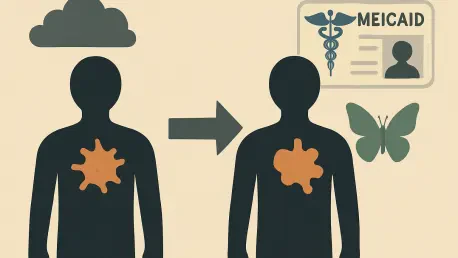Imagine a world where a cancer diagnosis doesn’t come with the added burden of financial ruin, where access to life-saving treatment depends not on income or zip code but on need alone, and where policies like Medicaid expansion bring this vision closer to reality. This cornerstone of healthcare reform has sparked intense debate and research, especially given the stark disparities in cancer outcomes across the United States, making it critical to understand how expanded healthcare access impacts survival rates. This roundup gathers diverse perspectives from policy analysts, healthcare providers, and research bodies to explore the link between Medicaid expansion and improved five-year cancer survival rates, shedding light on a policy that could transform lives.
Diverse Perspectives on Medicaid Expansion’s Role in Cancer Care
Policy Analysts Weigh In on Systemic Impact
Policy experts have long argued that expanding Medicaid under the Affordable Care Act, implemented over a decade ago, serves as a vital tool for reducing healthcare inequities. Many highlight that states adopting this expansion have seen measurable gains in insurance coverage among low-income adults, directly correlating with better access to cancer screenings and early interventions. These systemic shifts are often credited with fostering environments where long-term survival becomes more attainable for marginalized groups.
A contrasting view among some analysts points to the uneven adoption across states as a persistent barrier. With 10 states still resisting expansion as of this year, the gap in outcomes between expansion and non-expansion regions remains a pressing concern. This divide prompts discussions on how federal incentives or mandates could bridge the disparity, ensuring uniform benefits nationwide.
Beyond immediate survival statistics, a segment of policy thought leaders emphasizes the economic ripple effects. They argue that reducing the financial strain of cancer care through broader coverage not only saves lives but also stabilizes communities by preventing medical debt, a factor often overlooked in health policy debates.
Healthcare Providers Share On-the-Ground Observations
From the front lines, oncologists and primary care physicians in expansion states report noticeable improvements in patient outcomes since the policy’s rollout. Many describe seeing more patients present at earlier stages of cancer, a shift attributed to increased access to preventive services like mammograms and colonoscopies. This early detection often translates into higher five-year survival rates, particularly for cancers with historically poor prognoses.
However, not all feedback is uniformly positive. Some providers in rural areas of expansion states note that while insurance coverage has grown, access to specialized care remains limited due to shortages of oncologists and treatment facilities. This bottleneck suggests that coverage alone isn’t a complete solution, prompting calls for complementary investments in healthcare infrastructure to maximize the policy’s impact.
Additionally, clinicians in non-expansion states express frustration over systemic barriers their patients face, often witnessing delayed diagnoses due to lack of insurance. These firsthand accounts underscore a consensus that while Medicaid expansion isn’t flawless, its absence creates a steeper uphill battle for both patients and providers in managing cancer care effectively.
Research Bodies Highlight Data-Driven Insights
Academic and health research organizations provide a wealth of data linking Medicaid expansion to enhanced cancer survival. Studies analyzing over a million cases reveal striking improvements in rural and low-income populations, with cause-specific survival rates rising by notable margins in states that embraced the policy. These findings often point to a 2 to 3 percentage point increase in survival metrics for vulnerable groups, a statistic that underscores the policy’s targeted effectiveness.
Diverging from purely positive interpretations, some research critiques the scope of these improvements, noting that broader healthcare reforms beyond Medicaid expansion may contribute to observed outcomes. This perspective urges caution in attributing gains solely to one policy, advocating for comprehensive studies that disentangle overlapping influences like private insurance marketplaces or public health campaigns.
Another angle from research circles focuses on equity, with data showing reduced racial disparities in survival rates, particularly among non-Hispanic Black patients in expansion states. Despite potential gaps in datasets due to missing sociodemographic information, the trend toward closing survival gaps is seen as a compelling argument for pushing expansion into resistant regions, potentially reshaping national cancer care landscapes.
Regional and Demographic Variations in Outcomes
Rural and High-Poverty Areas See Pronounced Benefits
Insights from multiple sources converge on the outsized benefits of Medicaid expansion in rural and high-poverty zones. Analysts and researchers alike note that patients in these areas, often burdened by limited healthcare access, have experienced significant boosts in survival rates, with some data indicating gains of over 3 percentage points in overall survival. This shift is frequently tied to newfound access to consistent treatment plans.
Healthcare providers in these regions add nuance, observing that while the policy has opened doors, logistical challenges like transportation to distant treatment centers persist. Their experiences suggest that survival improvements, though real, are tempered by structural hurdles that require localized solutions beyond insurance coverage.
Policy experts further dissect this trend, arguing that the success in underserved areas highlights Medicaid expansion’s role as a precision tool for health equity. They often advocate for tailored programs that pair coverage with community-based support systems to ensure that statistical gains translate into lived realities for every patient.
Racial Disparities and Incremental Progress
Across the board, contributors to this discussion acknowledge Medicaid expansion’s impact on narrowing racial gaps in cancer survival. Research findings consistently show a modest but meaningful increase in survival for minority groups, with some data reflecting a 1 percentage point rise for non-Hispanic Black patients. This progress is often framed as a step toward dismantling systemic inequities embedded in healthcare access.
Physicians working with diverse populations offer a ground-level perspective, noting that cultural and linguistic barriers still complicate care delivery, even with expanded coverage. Their input suggests that while survival statistics are improving, holistic approaches addressing trust and communication are essential to sustain momentum in reducing disparities.
On the policy front, experts stress that these incremental gains signal a broader potential for transformative change if expansion becomes universal. They often point to the remaining non-expansion states as critical battlegrounds for extending these equity-focused benefits, urging stakeholders to prioritize data-driven advocacy in those regions.
Challenges with High-Mortality Cancers and Access Barriers
When it comes to high-mortality cancers, research communities report encouraging shifts in long-term prognosis within expansion states, a finding echoed by clinicians who see more patients completing treatment cycles. This improvement is often linked to the ability to afford ongoing care, a direct outcome of broader insurance eligibility that prevents treatment dropouts.
Yet, a recurring theme from various sources is the persistent challenge of access barriers, even in states with expanded Medicaid. Providers frequently cite shortages of specialists and long wait times as factors that dilute the policy’s effectiveness for deadly cancer types, pushing for integrated solutions that address workforce and facility gaps.
Policy analysts add a strategic layer, suggesting that while the data on high-mortality cancers is promising, national adoption of expansion could amplify these gains significantly. They often contrast the progress in 26 expansion states against the lag in 12 holdouts, framing full implementation as a pivotal next step to tackle some of the deadliest diagnoses head-on.
Key Takeaways from the Discussion
Looking back, this roundup illuminated a multifaceted picture of Medicaid expansion’s impact on five-year cancer survival rates, drawing from policy analysts, healthcare providers, and research bodies. The consensus pointed to tangible benefits, especially for rural, low-income, and minority patients, with data showcasing survival rate increases that could reshape health equity narratives. Differing views on access barriers and the scope of policy impact enriched the conversation, revealing that while progress was evident, challenges like provider shortages and regional disparities demanded attention. Moving forward, stakeholders should prioritize advocating for expansion in resistant states, bolster rural healthcare infrastructure, and explore complementary policies that address systemic gaps. Further reading on health policy reforms and cancer care disparities can provide deeper context for those eager to drive change in this critical arena.









